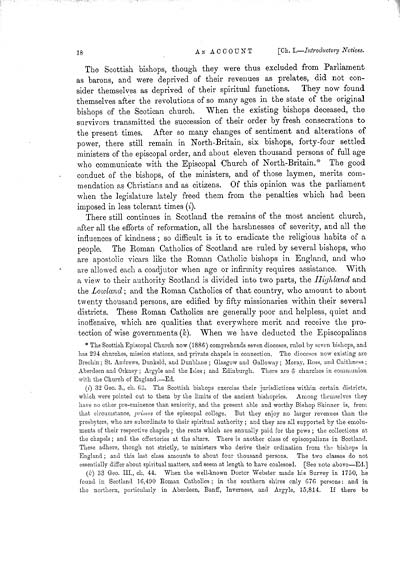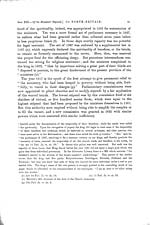Volume 3
(26) Page 18
Download files
Individual page:
Thumbnail gallery: Grid view | List view

18 The Scottish bishops, though they were thus excluded from Parliament as barons, and were deprived of their revenues as prelates, did not con- sider themselves as deprived of their spiritual functions. They now found themselves after the revolutions of so many ages in the state of the original bishops of the Scotican church. When the existing bishops deceased, the survivors transmitted the succession of their order by fresh consecrations to the present times. After so many changes of sentiment and alterations of power, there still remain in North-Britain, six bishops, forty-four settled ministers of the episcopal order, and about eleven thousand persons of full age who communicate with the Episcopal Church of North-Britain.* The good conduct of the bishops, of the ministers, and of those laymen, merits com- mendation as Christians and as citizens. Of this opinion was the parliament when the legislature lately freed them from the penalties which had been imposed in less tolerant times (i). There still continues in Scotland the remains of the most ancient church, after all the efforts of reformation, all the harshnesses of severity, and all the influences of kindness; so difficult is it to eradicate the religious habits of a people. The Roman Catholics of Scotland are ruled by several bishops, who are apostolic vicars like the Roman Catholic bishops in England, and who are allowed each a coadjutor when age or infirmity requires assistance. With a view to their authority Scotland is divided into two parts, the Highland and the Lowland; and the Roman Catholics of that country, who amount to about twenty thousand persons, are edified by fifty missionaries within their several districts. These Roman Catholics are generally poor and helpless, quiet and inoffensive, which are qualities that everywhere merit and receive the pro- tection of wise governments (k). When we have deducted the Episcopalians * The Scottish Episcopal Church now (1886) comprehends seven dioceses, ruled by seven bishops, and has 294 churches, mission stations, and private chapels in connection. The dioceses now existing are Brechin; St. Andrews, Dunkeld, and Dunblane ; Glasgow and Galloway; Moray, Ross, and Caithness ; Aberdeen and Orkney ; Argyle and the Isles ; and Edinburgh. There are 8 churches in communion with the Church of England.�Ed. (i) 32 Geo. 3., ch. 63. The Scottish bishops exercise their jurisdictions within certain districts, which were pointed out to them by the limits of the ancient bishoprics. Among themselves they have no other pre-eminence than seniority, and the present able and worthy Bishop Skinner is, from that circumstance, primus of the episcopal college. But they enjoy no larger revenues than the presbyters, who are subordinate to their spiritual authority; and they are all supported by the emolu- ments of their respective chapels ; the rents which are annually paid for the pews ; the collections at the chapels; and the offertories at the altars. There is another class of episcopalians in Scotland. These adhere, though not strictly, to ministers who derive their ordination from the bishops in England; and this last class amounts to about four thousand persons. The two classes do not essentially differ about spiritual matters, and seem at length to have coalesced. [See note above�Ed.] (k) 33 Geo. III., ch. 44. When the well-known Doctor Webster made his Survey in 1750, he found in Scotland 16,490 Roman Catholics; in the southern shires only G7G persons: and in the northern, particularly in Aberdeen, Banff, Inverness, and Argyle, 15,814. If there be
Set display mode to:
![]() Universal Viewer |
Universal Viewer | ![]() Mirador |
Large image | Transcription
Mirador |
Large image | Transcription
Images and transcriptions on this page, including medium image downloads, may be used under the Creative Commons Attribution 4.0 International Licence unless otherwise stated. ![]()
| Caledonia, or, An account, historical and topographic of North Britain from the most ancient to the present times > Volume 3 > (26) Page 18 |
|---|
| Permanent URL | https://digital.nls.uk/74528126 |
|---|---|
| Description | Vol. III. |
|---|---|
| Attribution and copyright: |
|

